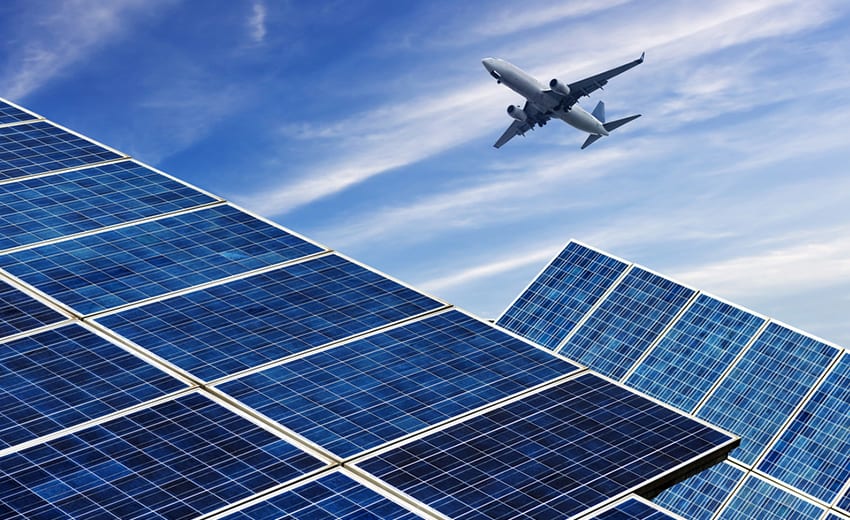As the aviation industry grapples with rising energy costs and increasing pressure to reduce carbon emissions, airports are turning to solar power as a sustainable and economically viable solution. The installation of solar panels at airports not only supports environmental goals but also offers significant benefits to operating budgets and revenue generation. This article explores how solar power can transform airports into models of efficiency and sustainability.
Economic Benefits of Solar Power
Reducing Operating Costs – One of the most compelling reasons for airports to invest in solar power is the potential for substantial reductions in operating costs. Solar panels can generate a significant portion of the electricity required for airport operations, from lighting and air conditioning to powering air traffic control systems and flight information displays. By producing their own electricity, airports can reduce their reliance on the grid, leading to lower energy bills.
For instance, Austin-Bergstrom International Airport (AUS) has already made strides in this direction. The airport installed 6,642 solar panels that generate 1.8 MW of power, which not only supports airport operations but also provides shaded parking for visitors5. This dual-purpose installation highlights how solar power can be integrated into existing infrastructure to maximize benefits.
Long-Term Financial Savings – Solar power installations are a long-term investment that can yield significant financial savings over time. Solar panels typically come with warranties of up to 30 years, ensuring a reliable source of energy for decades1. The initial capital expenditure can be offset by the savings on energy costs, making solar power a financially sound decision for airports.
Moreover, airports can take advantage of various financing options such as power purchase agreements (PPAs), which allow a third party to develop, finance, and maintain the solar installation. The airport then purchases the generated power at a predetermined rate, often lower than the current utility rates1. This model reduces the upfront costs and spreads the financial benefits over the life of the agreement.
Revenue Generation Opportunities
Leasing Land for Solar Farms – Airports often have vast areas of unused land that can be leased to solar developers for the installation of solar farms. This approach not only generates additional revenue through lease payments but also utilizes land that might otherwise remain idle. For example, Denver International Airport (DIA) has successfully implemented this model, installing 42,614 solar photovoltaic arrays with a capacity of 10 MW, which offsets nearly 12,000 metric tons of greenhouse gas emissions annually3.
Airports across the nation can follow this example by leasing land for solar projects, thereby creating a new revenue stream. The revenue generated from these leases can help offset operational costs and potentially reduce air travel costs for consumers, making the airport more competitive.
Selling Excess Power – Another revenue-generating opportunity lies in selling excess power back to the grid. Airports that produce more electricity than they consume can enter into agreements with local utilities to sell the surplus energy. This not only provides an additional income stream but also supports the local community by contributing to the overall renewable energy supply.
For instance, Austin-Bergstrom International Airport participates in Austin Energy’s Community Solar Program, where a portion of the energy generated by the airport’s solar panels is sent back to the grid for local residential customers to benefit from5. This model can be replicated at other airports across the nation to enhance their revenue potential.
Environmental and Social Benefits
Reducing Carbon Footprint – The aviation industry is a significant contributor to greenhouse gas emissions, and airports play a crucial role in mitigating this impact. By adopting solar power, airports can significantly reduce their carbon footprint. Solar energy is a clean, renewable source of power that does not emit harmful greenhouse gases, making it an environmentally friendly alternative to traditional fossil fuels.
Chattanooga Metropolitan Airport in Tennessee serves as a pioneering example, being the first U.S. airport to be powered entirely by solar energy5. Airports can draw inspiration from such initiatives to enhance their sustainability efforts and contribute to global carbon reduction goals.
Enhancing Public Image – Airports that invest in solar power can enhance their public image by demonstrating a commitment to sustainability and innovation. This can attract environmentally conscious travelers and businesses, boosting the airport’s reputation and potentially increasing passenger traffic. Additionally, airports can leverage their green credentials to secure funding and support from government and private entities focused on sustainability.
Technological Advancements and Future Trends
Innovations in Solar Technology – The future of solar power at airports looks promising, thanks to ongoing advancements in solar technology. Innovations such as thin-film solar panels and tandem solar cells are increasing the efficiency and affordability of solar installations2. Thin-film solar panels, for example, are flexible and can be integrated into various structures, including airport windows and facades, without compromising aesthetics.
Moreover, smart airport design can further enhance the use of solar power. Integrating solar charging points for electric vehicles in airport parking facilities is one such example that can provide additional benefits to travelers while promoting the use of clean energy2.
Government Support and Incentives – Government policies and incentives play a crucial role in promoting the adoption of solar power at airports. The Federal Infrastructure Bill, for instance, allocates significant funding for sustainability and energy efficiency projects at airports1. Airports can tap into these funds to support their solar initiatives, reducing the financial burden and accelerating project implementation.
Additionally, state and local governments are increasingly recognizing the importance of renewable energy. By aligning with these policies, airports can secure grants, tax credits, and other incentives that make solar power projects more financially viable.
The installation of solar power at airports offers a multitude of benefits, from reducing operating costs and generating additional revenue to enhancing sustainability and public image. As technological advancements continue to make solar power more efficient and affordable, and with strong government support, the future of solar-powered airports looks bright. By embracing solar energy, airports can lead the way in creating a more sustainable and economically resilient aviation industry.
Citations:
- https://www.aviationpros.com/airports/airport-technology/article/21257673/the-benefits-of-solar-power-at-airports
- https://sdg.iisd.org/commentary/guest-articles/solar-powered-airports-will-they-take-off/
- https://www.landgate.com/news/benefits-of-airport-solar-farms
- https://centreforaviation.com/analysis/reports/airports–the-environment-solar-power-begins-generating-stellar-savings-part-1—100-airports-act-250723
- https://solartribune.com/solar-power-takes-off-at-u-s-airports/
- https://www.aci-asiapac.aero/f/library/4552/Solar%20Energy%20for%20Airports%20Draft%20FINAL.pdf
- https://crp.trb.org/acrpwebresource4/acrp-report-141-renewable-energy-as-an-airport-revenue-source/
- https://nap.nationalacademies.org/read/25942/chapter/6
- https://www.copper.org/environment/sustainable-energy/renewables/solar/case-studies/A6176_Solar_Energy_Airports.pdf
- https://www.sciencedirect.com/science/article/abs/pii/S0969699717300297
- https://www.icao.int/environmental-protection/Documents/Energy%20at%20Airports.pdf
- https://www.thesmartere.in/industry-news/case-study-cial
- https://www.ecowatch.com/airports-and-solar-arrays-an-overview.html
- https://solutions4ga.com/solar-power-in-aviation/
- https://green.org/2024/01/30/solar-energy-in-the-aviation-industry/
- https://www.sunvalleysolar.com/blog/what-are-financial-benefits-solar-power
- https://www.pivotenergy.net/blog/budgeting-for-solar-in-2022
- https://www.investopedia.com/articles/investing/061115/economics-solar-power.asp
- https://www.icao.int/environmental-protection/Documents/ecoairports/Final%20Energy_at_Airports_Case_Studies.pdf
- https://www.rpsgroup.com/insights/consulting-uki/why-airports-should-consider-solar/
Veregy, LLC, is not a legal, tax, investment, or financial advisor, nor does Veregy directly finance any projects. Veregy, LLC’s content is for informational purposes only; any content readers should not construe any such information or other material as legal, tax, investment, or financial advice. Regardless of anything to the contrary, nothing available on or through Veregy LLC’s business practices should be understood as a recommendation that an individual or organization should not consult with a legal, tax, investment, or financial professional to address their particular circumstances.






